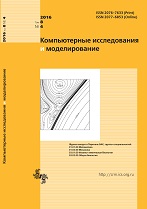|
This article is cited in 1 scientific paper (total in 1 paper)
SOLVING INDUSTRIAL PROBLEMS IN FLOWVISION SOFTWARE
Computational investigation of aerodynamic performance of the generic flying-wing aircraft model using FlowVision computational code
S. V. Kalashnikov, A. A. Krivoschapov, A. L. Mitin, N. V. Nikolaev
Central Aerohydrodynamic Institute (TsAGI),
1, Zhukovsky st., Zhukovsky, 140180, Russia
Abstract:
Modern approach to modernization of the experimental techniques involves design of mathematical models of the wind-tunnel, which are also referred to as Electronic of Digital Wind-Tunnels. They are meant to supplement experimental data with computational analysis. Using Electronic Wind-Tunnels is supposed to provide accurate information on aerodynamic performance of an aircraft basing on a set of experimental data, to obtain agreement between data from different test facilities and perform comparison between computational results for flight conditions and data with the presence of support system and test section.
Completing this task requires some preliminary research, which involves extensive wind-tunnel testing as well as RANS-based computational research with the use of supercomputer technologies. At different stages of computational investigation one may have to model not only the aircraft itself but also the wind-tunnel test section and the model support system. Modelling such complex geometries will inevitably result in quite complex vertical and separated flows one will have to simulate. Another problem is that boundary layer transition is often present in wind-tunnel testing due to quite small model scales and therefore low Reynolds numbers.
In the current article the first stage of the Electronic Wind-Tunnel design program is covered. This stage involves computational investigation of aerodynamic characteristics of the generic flying-wing UAV model previously tested in TsAGI T-102 wind-tunnel. Since this stage is preliminary the model was simulated without taking test-section and support system geometry into account. The boundary layer was considered to be fully turbulent.
For the current research FlowVision computational code was used because of its automatic grid generation feature and stability of the solver when simulating complex flows. A two-equation $k-\epsilon$ turbulence model was used with special wall functions designed to properly capture flow separation. Computed lift force and drag force coefficients for different angles-of-attack were compared to the experimental data.
Keywords:
flying-wing, electronic (digital) wind-tunnel, mathematical model of wind-tunnel.
Received: 01.11.2016
Revised: 21.12.2016
Accepted: 30.12.2016
Citation:
S. V. Kalashnikov, A. A. Krivoschapov, A. L. Mitin, N. V. Nikolaev, “Computational investigation of aerodynamic performance of the generic flying-wing aircraft model using FlowVision computational code”, Computer Research and Modeling, 9:1 (2017), 67–74
Linking options:
https://www.mathnet.ru/eng/crm47 https://www.mathnet.ru/eng/crm/v9/i1/p67
|

| Statistics & downloads: |
| Abstract page: | 295 | | Full-text PDF : | 187 | | References: | 23 |
|




 Contact us:
Contact us: Terms of Use
Terms of Use
 Registration to the website
Registration to the website Logotypes
Logotypes








 Citation in format
Citation in format 
